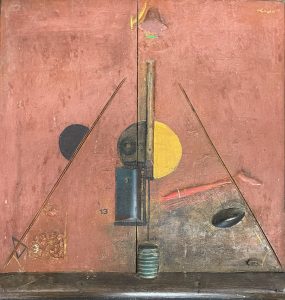
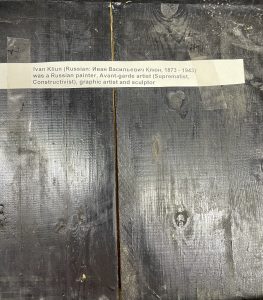
 1. Ivan Kliun Russian avant-garde style, Contre relief en bois blending elements of Suprematism and Constructivism. The three dimensional composition of wood elements and mounding affixed to two dark planks is dominated by a warm, reddish-brown background, against which Kliun has arranged a series of geometric forms including circles, triangles, and rectangular shapes. A central vertical element divides the substrate, while thin lines create an overlaying triangular structure. The limited color palette – primarily brown, black, yellow, with touches of blue and red – is characteristic of Suprematist works. Various textures and materials of this mixed-media approach, aligning with Constructivist techniques. Abstract forms dominate, avoiding direct representation and embracing non-objective art principles. The visible number “13” adds an intriguing symbolic or numeric element. Overall, this piece showcases Kliun’s mastery in balancing geometric abstraction with constructed space, reflecting his significant contribution to early 20th- century modernist art movements in Russia.
1. Ivan Kliun Russian avant-garde style, Contre relief en bois blending elements of Suprematism and Constructivism. The three dimensional composition of wood elements and mounding affixed to two dark planks is dominated by a warm, reddish-brown background, against which Kliun has arranged a series of geometric forms including circles, triangles, and rectangular shapes. A central vertical element divides the substrate, while thin lines create an overlaying triangular structure. The limited color palette – primarily brown, black, yellow, with touches of blue and red – is characteristic of Suprematist works. Various textures and materials of this mixed-media approach, aligning with Constructivist techniques. Abstract forms dominate, avoiding direct representation and embracing non-objective art principles. The visible number “13” adds an intriguing symbolic or numeric element. Overall, this piece showcases Kliun’s mastery in balancing geometric abstraction with constructed space, reflecting his significant contribution to early 20th- century modernist art movements in Russia.
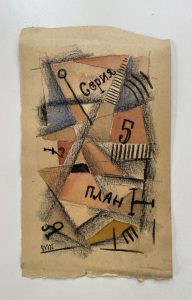 2. Constructivist Composition with Cyrillic Text Mixed media on paper Approx. 5 x 9 inches (12.7 x 22.9 cm) This mixed-media composition features geometric shapes and bold Cyrillic lettering, reminiscent of the Russian Constructivist movement of the early 20th century. The design emphasizes angular forms, intersecting lines, and a color palette of warm earth tones. Words like “Серия” (Series) and “План” (Plan) suggest an industrial or architectural theme, both common in Constructivist works. The inclusion of abstract numbers and technical imagery reinforces the movement’s connection to utilitarian design, technology, and mechanization.
2. Constructivist Composition with Cyrillic Text Mixed media on paper Approx. 5 x 9 inches (12.7 x 22.9 cm) This mixed-media composition features geometric shapes and bold Cyrillic lettering, reminiscent of the Russian Constructivist movement of the early 20th century. The design emphasizes angular forms, intersecting lines, and a color palette of warm earth tones. Words like “Серия” (Series) and “План” (Plan) suggest an industrial or architectural theme, both common in Constructivist works. The inclusion of abstract numbers and technical imagery reinforces the movement’s connection to utilitarian design, technology, and mechanization.
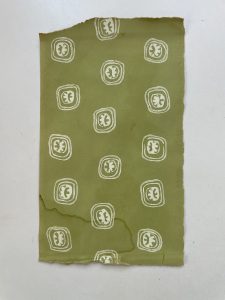 The reverse side of the artwork shows a patterned green paper, possibly from a notebook or re-used paper, adding to its vernacular quality. The rough, untrimmed edges and visible wear further suggest the piece was created during a period of experimental artistic production. Provenance: Private collection.
The reverse side of the artwork shows a patterned green paper, possibly from a notebook or re-used paper, adding to its vernacular quality. The rough, untrimmed edges and visible wear further suggest the piece was created during a period of experimental artistic production. Provenance: Private collection.
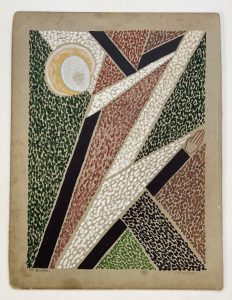
3. Aleksandr Davidovich Drevin (1889–1938) Abstract Composition, ca. 1920s Gouache on paper Approx. 7 x 9 inches (17.8 x 22.9 cm) This striking abstract gouache on paper, attributed to the noted Russian avant-garde artist Aleksandr Drevin, reflects the artist’s engagement with modernist geometric abstraction during the early Soviet period. The composition features dynamic diagonal lines intersected by rich fields of textured color. Drevin’s characteristic use of earthy, organic tones contrasts sharply with bold black lines, creating a rhythmic and vibrant visual experience. Aleksandr Drevin, known for his contributions to Russian avant-garde art, explored non- objective forms in the 1920s, drawing inspiration from Suprematism and Constructivism. His work frequently eschewed realistic representation in favor of dynamic compositions that expressed the pure essence of color and form. This particular piece, with its controlled palette and textured patterns, conveys the sense of movement and energy central to his practice.
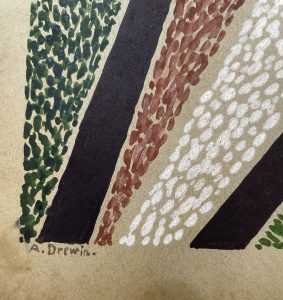 The artwork is signed A. Drevin in the lower left corner, further reinforcing the attribution.
The artwork is signed A. Drevin in the lower left corner, further reinforcing the attribution.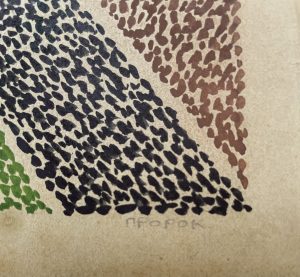
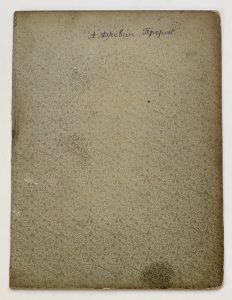
The verso bears inscriptions in Russian, including the artist’s name and a secondary, faded label. Lower right appears to have the term “ПФОРК,” which could be an abbreviation or stylized signature in Cyrillic. Provenance: Private collection.
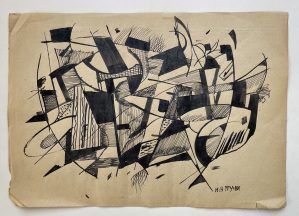 4. Attributed to Russian Avant-Garde Artist, ca. 1920s Abstract Geometric Composition Ink on paper Approx. 7 x 10 inches (17.8 x 25.4 cm) This intricate ink drawing on paper showcases the dynamic and fragmented geometric forms that are emblematic of the Russian avant-garde, a movement that revolutionized the visual arts in the early 20th century. The composition is dominated by angular, intersecting planes and bold black lines, which create a sense of rhythm and movement across the page. The artist’s use of varying line weights and hatching techniques adds depth and texture to the abstract forms, evoking influences from both Constructivism and Suprematism. In the lower right corner, the piece is inscribed with what appears to be a Cyrillic signature, although the exact attribution remains unclear. The abstract forms, however, suggest the hand of an artist closely aligned with the geometric experimentation of artists like El Lissitzky or Lyubov Popova.
4. Attributed to Russian Avant-Garde Artist, ca. 1920s Abstract Geometric Composition Ink on paper Approx. 7 x 10 inches (17.8 x 25.4 cm) This intricate ink drawing on paper showcases the dynamic and fragmented geometric forms that are emblematic of the Russian avant-garde, a movement that revolutionized the visual arts in the early 20th century. The composition is dominated by angular, intersecting planes and bold black lines, which create a sense of rhythm and movement across the page. The artist’s use of varying line weights and hatching techniques adds depth and texture to the abstract forms, evoking influences from both Constructivism and Suprematism. In the lower right corner, the piece is inscribed with what appears to be a Cyrillic signature, although the exact attribution remains unclear. The abstract forms, however, suggest the hand of an artist closely aligned with the geometric experimentation of artists like El Lissitzky or Lyubov Popova.
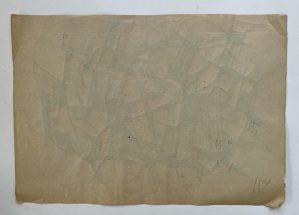 The verso features faint, additional sketching or underdrawings, possibly suggesting the development of the composition. This artifact adds to the piece’s historical interest and its connection to the experimental processes of the Russian avant-garde. Provenance: Private collection.
The verso features faint, additional sketching or underdrawings, possibly suggesting the development of the composition. This artifact adds to the piece’s historical interest and its connection to the experimental processes of the Russian avant-garde. Provenance: Private collection.
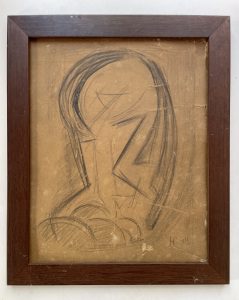 5. Unknown Artist, Russian Avant-Garde, ca. 1920s Abstract Cubist Head Graphite on paper (not examined out of frame) 9 x 11 inches (22.9 x 27.9 cm) This striking graphite drawing, executed with strong, fluid lines, evokes the influence of Cubism and Futurism within the broader context of the Russian avant-garde. The abstracted head, rendered through angular and geometric forms, captures the essence of modernist experimentation with form and structure. The artist employs a minimalistic approach, using graphite to create bold, overlapping contours that suggest both the complexity and simplicity of the human figure in abstract terms.
5. Unknown Artist, Russian Avant-Garde, ca. 1920s Abstract Cubist Head Graphite on paper (not examined out of frame) 9 x 11 inches (22.9 x 27.9 cm) This striking graphite drawing, executed with strong, fluid lines, evokes the influence of Cubism and Futurism within the broader context of the Russian avant-garde. The abstracted head, rendered through angular and geometric forms, captures the essence of modernist experimentation with form and structure. The artist employs a minimalistic approach, using graphite to create bold, overlapping contours that suggest both the complexity and simplicity of the human figure in abstract terms.
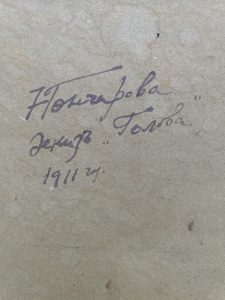 The drawing remains housed in its original wooden frame, which, coupled with the condition of the paper, suggests the work was produced in the early 20th century. The signature in the lower right corner, although faint, could offer further clues regarding attribution upon closer examination. Attributed to Natalia Goncharova (1881–1962)
The drawing remains housed in its original wooden frame, which, coupled with the condition of the paper, suggests the work was produced in the early 20th century. The signature in the lower right corner, although faint, could offer further clues regarding attribution upon closer examination. Attributed to Natalia Goncharova (1881–1962)
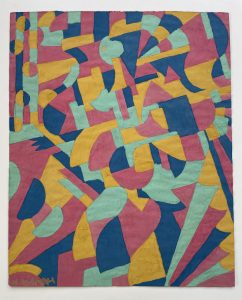
6. Abstract Composition, 1911 Watercolor or gouache on paper Approx. 9 x 12 inches (22.9 x 30.5 cm)
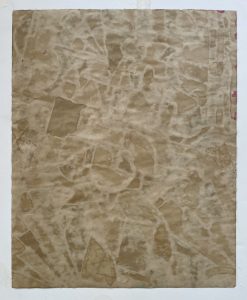
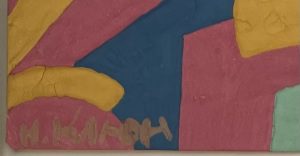
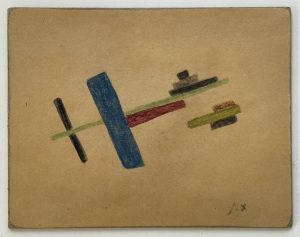
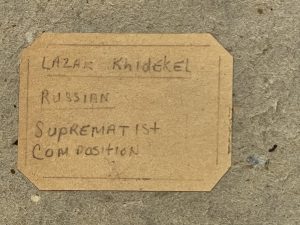 7. Lazar Khidekel (1904–1986) Suprematist Composition, ca. 1920s Gouache on artist board; signed lower left Approx. 7 x 9 inches (17.8 x 22.9 cm) This vibrant gouache on paper exemplifies the bold geometric abstraction characteristic of Lazar Khidekel’s contributions to the Suprematist movement. Khidekel, a student of Kazimir Malevich, was one of the few artists to transition Suprematist ideals beyond the canvas, incorporating them into visionary architectural projects. This composition, likely created in the 1920s, features intersecting diagonal lines and dynamic geometric shapes rendered in muted earth tones alongside areas of bold black and vibrant ochre. The piece, with its textured brushwork and rhythmic arrangement of forms, reflects the movement’s emphasis on pure artistic feeling, divorced from representational reality. Khidekel’s compositions often explore the relationship between basic geometric elements and the surrounding space, conveying movement and energy within a static frame.
7. Lazar Khidekel (1904–1986) Suprematist Composition, ca. 1920s Gouache on artist board; signed lower left Approx. 7 x 9 inches (17.8 x 22.9 cm) This vibrant gouache on paper exemplifies the bold geometric abstraction characteristic of Lazar Khidekel’s contributions to the Suprematist movement. Khidekel, a student of Kazimir Malevich, was one of the few artists to transition Suprematist ideals beyond the canvas, incorporating them into visionary architectural projects. This composition, likely created in the 1920s, features intersecting diagonal lines and dynamic geometric shapes rendered in muted earth tones alongside areas of bold black and vibrant ochre. The piece, with its textured brushwork and rhythmic arrangement of forms, reflects the movement’s emphasis on pure artistic feeling, divorced from representational reality. Khidekel’s compositions often explore the relationship between basic geometric elements and the surrounding space, conveying movement and energy within a static frame.
The verso bears a handwritten label identifying the work as a Suprematist Composition by Lazar Khidekel, further underscoring its connection to the Russian avant-garde. Provenance: Private collection.
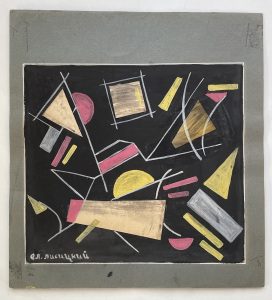
8. El Lissitzky (1890–1941) Abstract Geometric Composition Gouache and mixed media on paper Approx. 8 x 8.5 inches (20.3 x 21.6 cm) This dynamic abstract composition by El Lissitzky, a prominent figure in the Russian avant-garde, exemplifies the artist’s exploration of geometric abstraction and his pioneering role in the Suprematist and Constructivist movements. The composition consists of vibrant geometric shapes—triangles, circles, and rectangles—arranged in a seemingly weightless, floating array. The interplay between the bold black background and the bright colors—yellows, reds, and pinks—creates a strong sense of depth and movement, evoking Lissitzky’s architectural and design sensibilities. 
Lissitzky’s signature, written in Cyrillic, appears in the lower left corner, further reinforcing the work’s connection to the artist. Known for his contributions to both art and design, Lissitzky’s work pushed the boundaries of traditional painting, integrating his interests in architecture and graphic design into his visual art. This composition is a compelling example of his ability to reduce form to its most essential, geometric elements while maintaining a profound sense of spatial exploration.
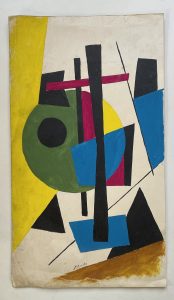
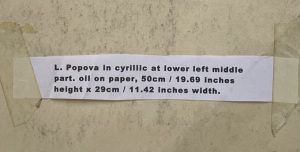
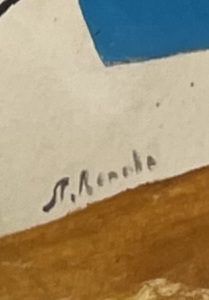 9. Attributed to Liubov Sergeevna Popova, ca. 1920s Geometric Suprematist Composition Gouache on paper Approx. 7 x 12 inches (17.8 x 30.5 cm) This bold geometric composition, rendered in gouache on paper, is characteristic of the Russian Suprematist movement. The work features overlapping geometric shapes—circles, triangles, and rectangles—arranged dynamically within a strong black, white, and primary color palette. The interplay of flat planes and abstract forms creates a sense of weightlessness and movement, emphasizing Suprematism’s focus on non- representational forms. The vibrant green, blue, red, and yellow hues contribute to the visual rhythm, while the stark black lines dissect the space, reinforcing the movement’s exploration of spatial relationships and abstract geometry. The composition exemplifies the radical departure from traditional realism that characterized the Russian avant-garde, a revolutionary artistic movement that sought to redefine art’s role in society. A label on the verso provides additional details about the piece, though further research is required to attribute it definitively to a specific artist within the Suprematist circle.
9. Attributed to Liubov Sergeevna Popova, ca. 1920s Geometric Suprematist Composition Gouache on paper Approx. 7 x 12 inches (17.8 x 30.5 cm) This bold geometric composition, rendered in gouache on paper, is characteristic of the Russian Suprematist movement. The work features overlapping geometric shapes—circles, triangles, and rectangles—arranged dynamically within a strong black, white, and primary color palette. The interplay of flat planes and abstract forms creates a sense of weightlessness and movement, emphasizing Suprematism’s focus on non- representational forms. The vibrant green, blue, red, and yellow hues contribute to the visual rhythm, while the stark black lines dissect the space, reinforcing the movement’s exploration of spatial relationships and abstract geometry. The composition exemplifies the radical departure from traditional realism that characterized the Russian avant-garde, a revolutionary artistic movement that sought to redefine art’s role in society. A label on the verso provides additional details about the piece, though further research is required to attribute it definitively to a specific artist within the Suprematist circle.
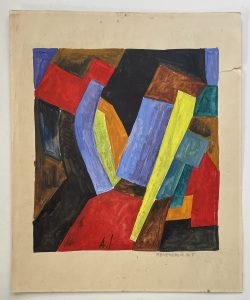
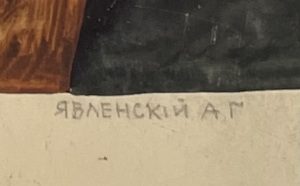 Abstract Geometric Composition
Abstract Geometric Composition
10. Attributed to Alexej von Jawlensky (1864–1941)
Abstract Geometric Composition, ca. 1920s
Gouache on paper
Approx. 9 x 12 inches (22.9 x 30.5 cm)
This vibrant abstract geometric composition features bold intersecting shapes rendered in saturated primary colors—red, blue, yellow, and green—balanced against deep black and brown tones. The composition evokes a dynamic sense of movement, characteristic of early 20th-century Russian avant-garde works, yet with a painterly approach more often associated with Expressionism.
The piece is signed in Cyrillic as “Явленский А. Г.” (Yavlensky A. G.), suggesting an attribution to Alexej von Jawlensky, a prominent Russian-born artist who became a key figure in German Expressionism and a member of the Blue Rider group. While Jawlensky is primarily known for his abstract portraits and colorful, emotive landscapes, this work suggests a possible foray into geometric abstraction, offering a rare glimpse into a different aspect of his artistic output.
Further research and authentication are required to fully confirm the authorship and context of this work. It may represent a unique or experimental phase in Jawlensky’s oeuvre, or possibly a piece influenced by the avant-garde movements active during the 1920s.
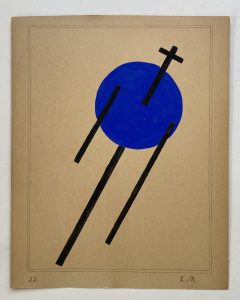 11. Suprematist Composition Attributed to Russian Avant-Garde Artist, ca. 1920s Gouache on paper Approx. 9 x 12 inches (22.9 x 30.5 cm) This striking gouache composition employs minimalist geometric forms—a solid blue circle and intersecting black lines—evoking the stark visual language of the Suprematist movement. The artist’s precision in the arrangement of the shapes demonstrates the Suprematists’ preoccupation with pure geometry and the abstraction of form. Signed with a possible initial E. M. in the lower right corner. The signature “E. M.” on this work is intriguing, and while it’s not immediately clear who the artist might be, a few possibilities come to mind within the context of Russian avant-garde and Constructivist movements:
11. Suprematist Composition Attributed to Russian Avant-Garde Artist, ca. 1920s Gouache on paper Approx. 9 x 12 inches (22.9 x 30.5 cm) This striking gouache composition employs minimalist geometric forms—a solid blue circle and intersecting black lines—evoking the stark visual language of the Suprematist movement. The artist’s precision in the arrangement of the shapes demonstrates the Suprematists’ preoccupation with pure geometry and the abstraction of form. Signed with a possible initial E. M. in the lower right corner. The signature “E. M.” on this work is intriguing, and while it’s not immediately clear who the artist might be, a few possibilities come to mind within the context of Russian avant-garde and Constructivist movements:
1. El Lissitzky (Лазарь Маркович Лисицкий) – While typically signing his work “El Lissitzky” or “Lissitzky,” his initials are E.M. (Lazar Markovich Lissitzky), and he was a leading figure in Suprematism and Constructivism. However, his full name or surname is more commonly seen on his works, making this a less likely direct connection.
2. Evgenii Mikhailovich – It’s possible that the initials could belong to an artist or designer active in the 20th century, but not widely recognized in mainstream art history, especially if the work was done in a later period as a continuation of the Suprematist tradition.
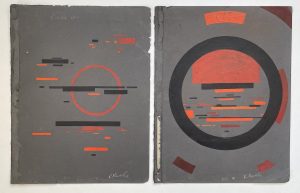
12 & 13. Vladimir Markov (Attributed)
Two Geometric Suprematist Compositions:
Gouache on paper
Approx. 9 x 12 inches (22.9 x 30.5 cm) each
These two abstract gouache compositions are attributed to the Russian avant-garde artist Vladimir Markov, featuring bold geometric forms in the style of Suprematism. The stark black and red shapes, arranged against a gray background, align with the movement’s emphasis on pure abstraction and non-objective form. The interplay of concentric circles, rectangles, and lines reflects the revolutionary artistic ideals of Suprematism, which sought to transcend representation and explore the spatial and philosophical possibilities of geometric shapes.
Each work bears a stamp from UNOVIS (Utverditeli Novogo Iskusstva, Champions of the New Art), a group founded by Kazimir Malevich in 1919, which disbanded in 1922. This stamp strongly suggests that the works were procured or created for exhibition or use within the UNOVIS school or gallery, a revolutionary center for the development and promotion of Suprematism. The handwritten notations in Cyrillic, signed“М.” (which possibly stands for Malevich), could indicate Malevich’s personal annotations or approval for exhibition or pedagogical use within the UNOVIS framework. These markings enhance the historical significance of the pieces, potentially linking them to one of the most radical artistic movements of the 20th century.
While the exact date remains unclear due to the faded inscription, the style and provenance suggest the works may have been produced after Markov’s death in 1914, around c1920, during the height of UNOVIS’s influence– . The involvement of Malevich’s school, along with the possibility of his annotations, adds layers of historical intrigue and makes these works prime candidates for further scholarly research and authentication.
Given the absence of extensive comparable works by Vladimir Markov, these pieces present a significant opportunity for discovery within the context of Russian avant-garde art. The connection to Malevich and UNOVIS warrants more in-depth investigation by experts in the field of Suprematist art and early 20th-century Russian movements.
Provenance: Private collection.
Note: These works are accompanied by strong circumstantial evidence of their connection to Vladimir Markov and Kazimir Malevich’s UNOVIS group. However, additional research, examination, and authentication by specialists in Russian avant-garde art are recommended to confirm their authorship and historical context.
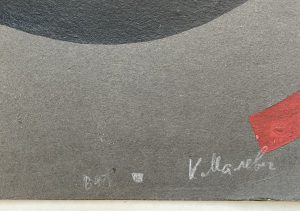
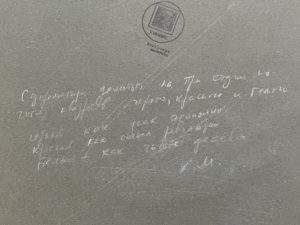
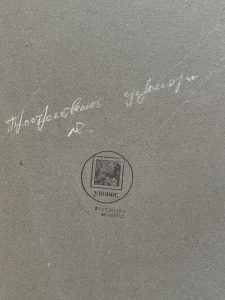
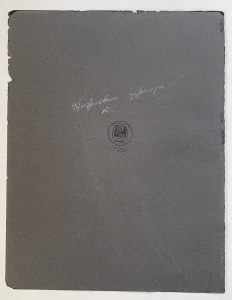
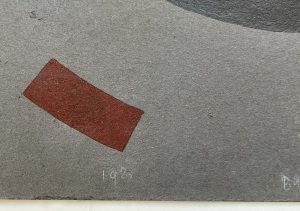
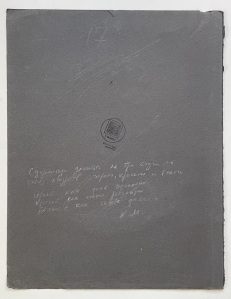
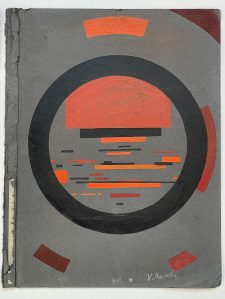
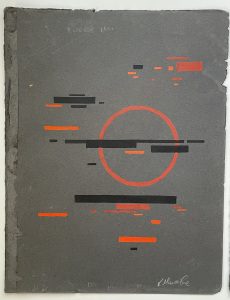
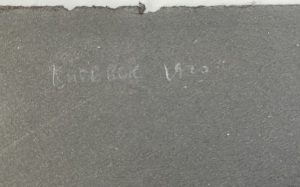

Unovis (УНОВИС) was a significant Russian avant-garde art group formed in the early 20th century. Here are the key points about Unovis:
- Full name: УНОВИС stands for “Утвердители нового искусства” (Utverditeli Novogo Iskusstva), which translates to “Champions of New Art” or “Affirmers of the New Art.”
- Founded: The group was established in 1919 in Vitebsk, Belarus (then part of Soviet Russia).
- Key figure: Kazimir Malevich, the pioneer of geometric abstract art and the creator of Suprematism, was the central figure and leader of Unovis.
- Philosophy: Unovis promoted Suprematism, an art movement focused on basic geometric forms and a limited color palette, often just black and white.
- Influence: The group had a significant impact on the development of abstract art and design in the early Soviet period.
- Members: Besides Malevich, other notable members included El Lissitzky, Vera Ermolaeva, and Nikolai Suetin.
- Activities: Unovis was involved in various artistic and educational activities, including creating propaganda art for the new Soviet state.
- Legacy: While short-lived (it disbanded in the early 1920s), Unovis had a lasting influence on modernist art and design, particularly in typography and architecture.
